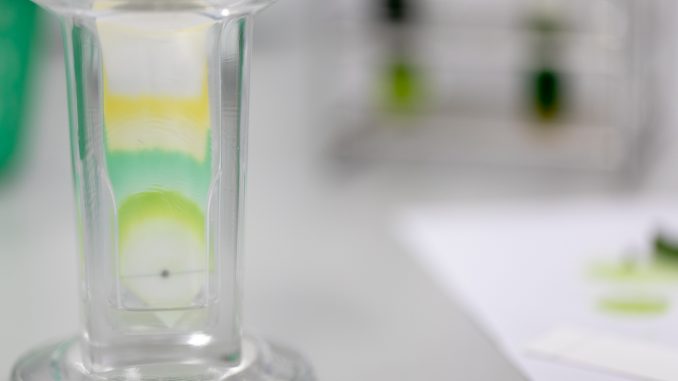
Expanded bed chromatography is one of the most recent separation techniques to come into vogue with biochemical downstream processors. It is one of a group of chromatographic separation techniques that exploit differential adsorption methods. It is also closely allied with fluidized bed adsorption and the two methods almost parallel each other in style and design of operation.
As with most downstream processing operations, there is a requirement to remove all cells, unwanted fermentation substrates and byproducts, and cellular debris using technologies such as centrifugation and microfiltration.
The next step may well involve a much more specific type of chromatographic-like separation. Expanded bed chromatography is one such approach.
The matrix in the form of resin beads is placed in a column chromatography system. The column is fluidised where the resin beads form a concentration gradient. As with column chromatography, the material to be separated including cells and other debris is fed into the column. The extraneous, unwanted material passes through whilst the material of interest is absorbed onto the resin. The column is operated as in a fluidized bed.
The column containing resin to which is bound the absorbed material of interest is repacked. The flow is reversed as in conventional axial chromatography and the material of interest eluted from the column.
It has the distinct advantage over technologies such as centrifugation, membrane processing and even conventional chromatography in that a number of downstream processing steps are amalgamated into one. The material of interest is removed directly from the adsorbent without having to remove the cell debris in a separate unit because that was removed earlier when the column was operated in an expanded bed form. In doing so, time and cost are reduced.
In a conventional column system the direction of flow is always in the same direction. The adsorbent is always confined with in the column where it is constrained by a sinter. Clogging will occur because cell debris simply cannot pass through the interspatial area around the beads.
In an expanded bed system, having flow directed upwards from the bottom means that the resin is free to move with the flow. The resin expands to fill any free volume which creates larger spaces between the beads. Any other particulates small enough to pass through the upper sinter are removed with the flow.
– Applications Of Note
Most applications reported in the literature use expanded bed chromatography to recover protein from very crude, dirty feedstocks (Chase, 1994). The expanded bed adsorption approach is ideal for dealing with extracellular proteins from fermentation broths, proteins released from deliberately disrupted cells. The great benefit compared to using a fixed bed in the conventional sense for adsorption is that there is no need to remove suspended solids that would block packed beds. Using this technology means that the complexity of down stream processing is reduced by removing clarification steps such as membrane filtration or centrifugation.
The article by Chase (1994) is a good starting point in designing and optimizing an adsorption process making use of an expanded bed which also relies on the principles of operation of packed beds.
More specific applications include purification of plasmid DNA extracted from bacteria. Here the bacteria is lysed in detergent solution. The material containing the plasmid DNA is passed through an anion exchange expanded bed column. The benefit of this system was the absence of any toxic materials used such as ethidium bromide or phenol.
Another key application has been the use of affinity chromatography in an EBA form. Here, the researchers generated a monoclonal antibody that bound a protein found on the spores of an opportunistic protozoan parasite called Enterocytozoon bieneusi. The monoclonal antibody was bound to an adsorbent. The researcher than isolated spores of the parasite from human stool samples. These spores were detected by an immunofluoresence antibody diagnostic.
Streamline Direct HST
A new kind of mixed-mode adsorbent called Streamline Direct HST was designed and developed for expanded bed and fluidized bed use. The adsorbent can capture any target protein directly from a moderately ionic strength feedstock without the need of dilution or other additives (Gao et al., 2007).
The Gao et al. article (2007) discusses the findings for binding of bovine serum albumin (BSA) to Streamline Direct HST. The adsorption of this albumin is very much in keeping with protein adsorption so there are no particular surprises with the use of the matrix. There is salt-independent adsorption of the protein and the maximum binding capacity of BSA is near this protein’s isoelectric point.
References
Chase, H. A. (1994). Purification of proteins by adsorption chromatography in expanded beds. Trends in Biotechnology, 12(8), pp. 296-303 (Article).
Gao, D., Lin, D.Q., Yao, S.J. (2007) Mechanistic analysis on the effects of salt concentration and pH on protein adsorption onto a mixed-mode adsorbent with cation ligand. J Chromatogr. B Analyt. Technol. Biomed. Life Sci. Nov 1;859(1) pp. 16-23. doi: 10.1016/j.jchromb.2007.08.044. Epub 2007 Sep 19. PMID: 17913599. (Article).
Leave a Reply